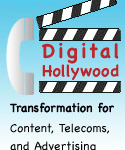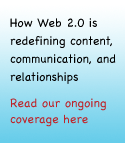Now Everyone Is a Producer—How Will User-Generated Content Affect Traditional Media?
 User-generated media (UGM) represents a poignant dichotomy within the context of Digital Hollywood Chicago: panelists and speakers represented a full spectrum of players that provide the capability for people to communicate, work and entertain themselves, but they have in common that they represent business interests. These players are in the business of commercializing communication. Consumers (aka “users,” “people”) represent personal interests: they communicate because they want to; they have little commercial interest in most of their communication.
User-generated media (UGM) represents a poignant dichotomy within the context of Digital Hollywood Chicago: panelists and speakers represented a full spectrum of players that provide the capability for people to communicate, work and entertain themselves, but they have in common that they represent business interests. These players are in the business of commercializing communication. Consumers (aka “users,” “people”) represent personal interests: they communicate because they want to; they have little commercial interest in most of their communication.
Panelists grappled with this reality but did not address it directly. They explored business models for UGM—and mostly came up empty. The problem that UGM poses to providers is two-fold: UGM costs providers money in terms of bandwidth and other resources. It also carries a considerable opportunity cost, which is hard to measure but palpable: it crowds out commercial content by occupying customers in two ways: creating UGM and experiencing others’ UGM.
UGM is also difficult to compete against because its producers play by much different rules: they usually produce for free, while commercial producers have high costs. UGM producers look at situations in different ways: since their goal is to communicate and gain attention, they have fewer constraints than commercial players, who strive to make a profit True, UGM producers have fewer resources and skills, so they lose in almost any bake-off with commercial producers. Except relevance, credibility and trust.
 Panelists
Panelists
- Venu Vasudevan, Ph.D., Director, Mobile Platforms, Applications Research Center, Motorola Labs—Venu Vasudevan oversees Mobile Platforms research at Motorola Labs developing next generation platforms and services for Motorola’s vision of Seamless Mobility.
- Kristin L. Holland, Partner, Katten Muchin Rosenman—Kristin L. Holland helps clients resolve business disputes. She maintains a diverse civil trial practice and has significant experience with intellectual property, fiduciary duty and real estate claims.
- Mark Renshaw, SVP One-to-One Marketing Solutions, Arc Worldwide—Mark transferred in May 2006 to Arc Worldwide’s Chicago office from Singapore, where he directed Arc’s digital marketing efforts across Asia-Pacific. As SVP of one-to-one marketing solutions in the US, he will oversee teams in Chicago, New York and San Francisco as they respond to clients’ increasing needs for digital marketing solutions.
- Terry S. Bienstock, CEO, MobilActive—former EVP & General Counsel, Comcast Cable: Terry Bienstock is currently CEO of World Extend, LLC. a New Jersey-based distributor of managed application publishing and secure remote access solutions for business and consumer markets. WorldExtend has revolutionary products to deliver to a business a low cost software-based VPN, and has developed a virtual computer on a TV set to bridge the Digital Divide. He also manages and advises other ventures relating to new media platforms, such as Video-on-Demand, digital video recorders, broadband and mobile ser vices..
- John Furrier, CEO PodTech.Network—PodTech is the leading online video network featuring original technology and digital entertainment programming. PodTech’s media platform allows professional content producers to deliver their content to millions of people who can easily find, share, and interact with it.
- Moderator: Scott Cohen, Partner, Red Tie Media (VideoADGames)—Cohen rejoined Red Tie Media as a full-time partner and consultant to interactive businesses in May 2006. In addition, he presently serves on the Board of Directors and/or Board of Advisors for several Internet and technology companies, after serving as President of Game Trust, Inc. from 2004-2006.
General Observations
- The Web is an open platform, while TV is closed.
- Procter and Gamble offered consumers to be part of an online community, and five percent of customers provided content.
- Operators and providers have viewer information; they know what you’re watching, while Google is pushing the envelope with satellite. Influence is being redistributed. Look at Al Jazeera.
- Privacy is always an issue: data drives experience, but operators/carriers and advertisers must ask permission to gather personal data in order to suggest content and target advertising.
- Facebook integrates on- and off-line; MySpace doesn’t; they are both havens of UGM.
- Narrowcasting is critical to responding to niches.
User-distributed Content
- The litigation between YouTube and Viacom will have major repercussions for how content is used (YouTube users record content and post on YouTube for others to view without paying).
- Content owners have lost control over distribution. Films, for example, appear on the Internet before their premiers. the Internet is unforgiving; one copy out there gets replicated innumerable times.
- UGM has seen some recent successes like Fatrant and Lazy Sunday; however, when users reuse copyrighted content, they are at risk of being sued.
- Realistically, content owners are not going to sue individuals, except under unusual circumstances because they could face extensive negative publicity.
- Content owners are very leery of VOD (video on demand). They don’t want to be perceived as losing control of content.
- All content owners want to control their content. There are two key aspects of control: what is published and how it is used and manipulated. Watermarking can be an effective tool.
User-created Content
- Brands are losing control over their content and brands, and agencies need to think beyond old assumptions to advise clients appropriately. Coca-Cola came close to issuing a cease and desist to the men that did the Diet Coke-Mentos videos on YouTube.
- Content owners need to be paid. Is the old model dead?
- New mobile devices have more features that enable self-expression.
- User-generated advertising? People are creating their own advertisements for their favorite products and companies for their MySpace pages. These can conceivably gain widespread attention.
- YouTube is like a big nightclub; you can find anything there. The scarcity is attention. It’s the endorsement model that creates popularity.
- People consistently respond to good content, no matter the source.
Business Models
- It’s a perfect storm: Creative Commons (broadly, “use with attribution”) and open source principles will drive the growth of UGM. The question is how and where will the industry make money on it?
- Why isn’t UGM of higher value? For one thing, it has no commercial value because no one paid to produce it, so its value is unknown.
- Why does content have to be free, subsidized by advertising? The subscription model definitely works, although not in every situation. Offer free and “premium” services concurrently. People do spend money; look at the prices of rock concert tickets, and how people take pictures and make recordings with their phones.
- Yahoo is broken, and its founder has returned. The value now is in data (not content?).
- Will advertisers go to the one-on-one model, or will they continue to deal with distributors?
- The Internet has profoundly affected advertising because it enabled digitally trackable interaction to advertising. It set the bar, and broadcast advertising is struggling to move in that direction. Integrating the two can provide more value, for example, by distributing (TV) shows on the Internet the day after they air.
- Sports have a special dynamic because very few people want to watch after the outcome is decided. That increases the value of real-time viewing.
- Will the Internet compete with TV, or will they converge? YouTube shows video. But there is a chasm between them: TV is largely a passive activity while people interact more with computers.
- The long form will emerge on YouTube (TV length video). But the UGM requires extensive infrastructure, and who will pay? (servers to store it, bandwidth to distribute it).
- From the mobile perspective, devices are increasingly multimedia, which enables rich citizen journalism.
- To develop business models, executives have to think beyond lead generation; content can lead viewers to websites, where they can interact more and buy something.
- The industry needs new talent to take advantage of new rules and emerging opportunities. The industry needs to develop new metrics and business models.
Analysis and Conclusions
- Video content creation used to be a specialty practiced by very few highly trained people. It is rapidly going mainstream. Increasingly mobile phones contain video cameras for recording video and sound, and ubiquitous PC programs make editing far easier than ever. “Viewers” are now producers as well, and this fact is disconcerting to the industry.
- Two control issues emerge here: brand control and content control. Coke lost brand control with the Mentos incident, but the instigators created their own content. YouTube members who post the latest episode are not creating content; they are distributing it.
- No one is suggesting that the professional content business is going away; however, its role as the exclusive purveyor of video, audio and print content has ended. The most successful business models will feature collaboration (explicit or implicit) among customers and producers.
- UGM has significant competitive advantage over “professional” media. It is relevant, free and passionate. Because it has no commercial requirement, it exists for passion, and people respond to passion. Professional content is too often comprised of ideas in a blender: it serves no one in particular; it was designed for mass appeal. On the other hand, production costs preclude professionals from making content for highly specific audiences.
- One way to increase relevance is to bring production and distribution costs down. Collaborating with customers is an obvious solution—even though it will have to be discovered.
- One of the professional media’s toughest problems is dismantling itself while carrying on its business. All of its costs and processes were designed for the mass advertising market. High production and distribution (network affiliates) costs necessitate vacuous programming and extensive advertising.
- However, if content creators and advertisers do not respond, people will increasingly forsake them for alternatives, including UGM.
- UGM will only increase over time, and the industry needs to accept this fact. Then it can experiment aggressively with how to help customers to create, distribute and enjoy their content—in a way that increases the value of professional content.

Leave a Reply
You must be logged in to post a comment.